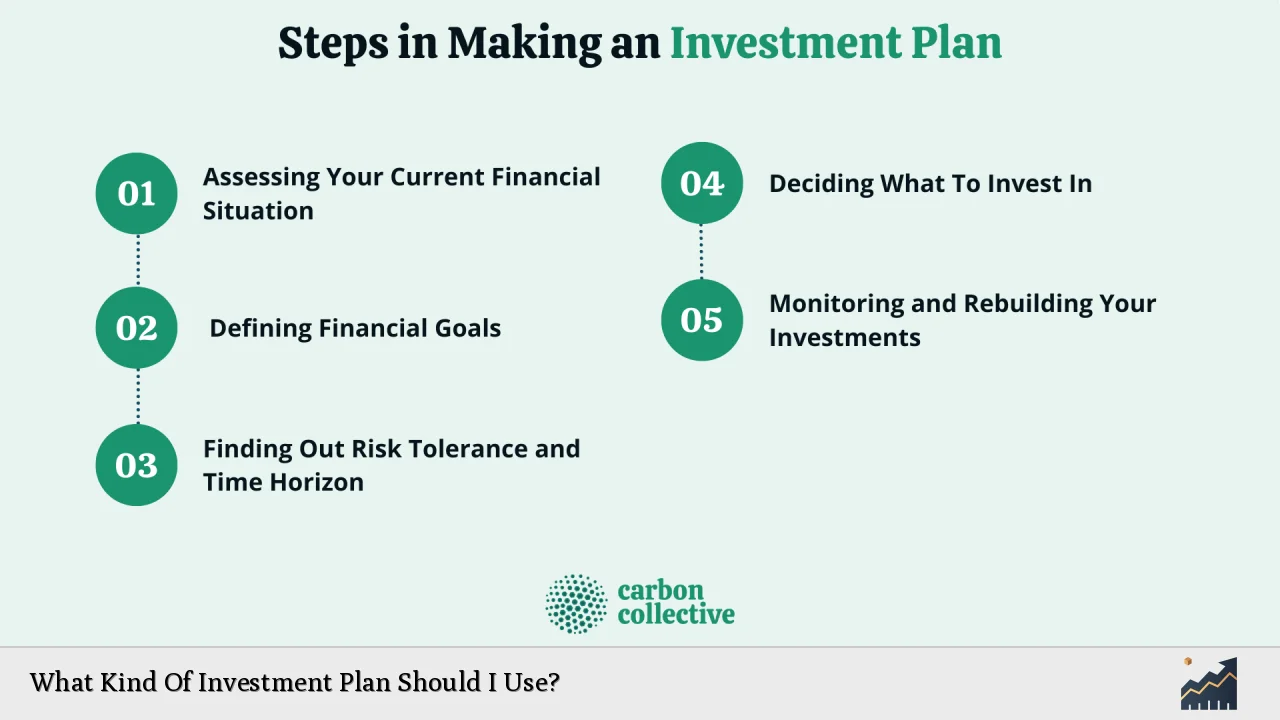Choosing the right investment plan is crucial for achieving your financial goals. The type of investment plan you should use depends on various factors including your financial situation, risk tolerance, and investment objectives. Understanding these elements will help you create a personalized investment strategy that aligns with your needs.
An effective investment plan requires careful consideration of your current financial status, future goals, and the types of investments available. It is essential to assess how much risk you are willing to take and how long you plan to invest. This will guide your decisions on asset allocation and the specific investment vehicles you choose.
In this article, we will explore different types of investment plans, their benefits, and how to determine which one is right for you.
| Investment Type | Description |
|---|---|
| Stocks | Ownership in a company with potential for high returns. |
| Bonds | Debt securities that provide fixed interest payments. |
| Mutual Funds | Pooled funds managed by professionals across various assets. |
| ETFs | Exchange-traded funds that offer diversification and liquidity. |
| Real Estate | Investment in property for rental income or appreciation. |
Assessing Your Financial Situation
Before diving into an investment plan, it is vital to assess your current financial situation. Start by evaluating your income, expenses, savings, and debts. Creating a budget can help you understand how much disposable income you have available for investing.
Consider your emergency fund as well; it’s important to have at least three to six months’ worth of living expenses saved before making significant investments. This safety net allows you to invest without the fear of needing to liquidate assets in case of unexpected expenses.
Once you have a clear picture of your finances, determine how much you can comfortably allocate towards investments. This amount should be based on what remains after covering essential expenses and contributing to savings.
Defining Your Financial Goals
After assessing your financial situation, the next step is to define your financial goals. What are you investing for? Common goals include saving for retirement, purchasing a home, funding education, or building wealth over time.
Your goals should be specific, measurable, achievable, relevant, and time-bound (SMART). For example, instead of saying “I want to save for retirement,” specify “I want to save $500,000 for retirement by age 65.” This clarity will help shape your investment strategy.
Additionally, consider the time horizon for each goal. Short-term goals (1-3 years) may require more conservative investments, while long-term goals (10+ years) can afford more aggressive strategies.
Understanding Your Risk Tolerance
Understanding your risk tolerance is crucial when selecting an investment plan. Risk tolerance refers to how much volatility you can handle in your investments without losing sleep at night. Factors influencing risk tolerance include:
- Age: Younger investors can typically afford to take more risks since they have time to recover from market downturns.
- Financial Situation: Those with stable incomes may be more comfortable taking risks compared to those with variable incomes.
- Investment Knowledge: More experienced investors may feel confident taking on higher risks than beginners.
To gauge your risk tolerance, consider taking a risk assessment questionnaire or consulting with a financial advisor. This information will guide you in choosing suitable investments that align with your comfort level.
Types of Investment Plans
There are various types of investment plans available, each catering to different needs and preferences. Here are some common options:
- Retirement Accounts: Such as 401(k)s or IRAs that offer tax advantages for long-term savings.
- Stocks: Investing in individual companies can yield high returns but comes with higher risk.
- Bonds: Generally safer than stocks, bonds provide fixed interest payments over time.
- Mutual Funds: These funds pool money from multiple investors to buy diversified portfolios managed by professionals.
- Exchange-Traded Funds (ETFs): Similar to mutual funds but traded on stock exchanges like individual stocks.
- Real Estate: Investing in property can provide rental income and potential appreciation over time.
Each type has its own benefits and drawbacks. It’s important to research each option thoroughly before making a decision.
Building Your Investment Portfolio
Once you’ve assessed your situation, defined your goals, understood your risk tolerance, and chosen an investment type, it’s time to build your investment portfolio. A well-diversified portfolio spreads risk across various asset classes. Here are some tips for building yours:
- Start with a mix of stocks and bonds based on your risk tolerance.
- Consider including alternative investments such as real estate or commodities for added diversification.
- Regularly review and rebalance your portfolio to maintain desired asset allocation as market conditions change.
- Use dollar-cost averaging by investing a fixed amount regularly regardless of market conditions. This strategy helps mitigate the impact of volatility.
By diversifying your investments and regularly reviewing them, you’ll be better positioned to achieve your financial goals while managing risk effectively.
Monitoring Your Investments
Investing is not a one-time event; it requires ongoing monitoring and adjustment. Regularly review your portfolio’s performance against your goals. If certain investments are underperforming or if market conditions change significantly, be prepared to adjust your strategy accordingly.
Consider setting up periodic reviews—quarterly or annually—to assess whether you’re on track towards achieving your objectives. During these reviews:
- Check if you’re still comfortable with the level of risk in your portfolio.
- Reassess your financial goals; they may evolve over time due to life changes such as marriage or having children.
- Make necessary adjustments based on performance data or changes in market conditions.
Staying proactive about monitoring ensures that you remain aligned with both market trends and personal financial aspirations.
Seeking Professional Advice
If you’re feeling overwhelmed or unsure about where to start with investing, consider seeking professional advice from a financial advisor. A qualified advisor can help tailor an investment strategy that suits your unique circumstances.
When choosing an advisor:
- Look for credentials such as Certified Financial Planner (CFP) or Chartered Financial Analyst (CFA).
- Ensure they have experience relevant to your specific needs—whether it’s retirement planning or wealth management.
- Discuss their fee structure upfront; understand whether they charge flat fees, commissions, or a percentage of assets managed.
Professional guidance can provide peace of mind and help navigate complex financial decisions effectively.
FAQs About Investment Plans
- What is an investment plan?
An investment plan outlines how you will allocate resources towards achieving specific financial goals. - How do I determine my risk tolerance?
You can assess risk tolerance through questionnaires or discussions with a financial advisor. - What types of investments should I consider?
Common options include stocks, bonds, mutual funds, ETFs, and real estate. - How often should I review my investment portfolio?
You should review it at least quarterly or annually based on performance and changing goals. - Should I seek professional advice for investing?
If you’re unsure about managing investments yourself, consulting a financial advisor can be beneficial.
By understanding these key components—financial assessment, goal definition, risk tolerance evaluation, portfolio building, monitoring strategies—you’ll be well-equipped to choose an investment plan that aligns with your unique circumstances and aspirations.

